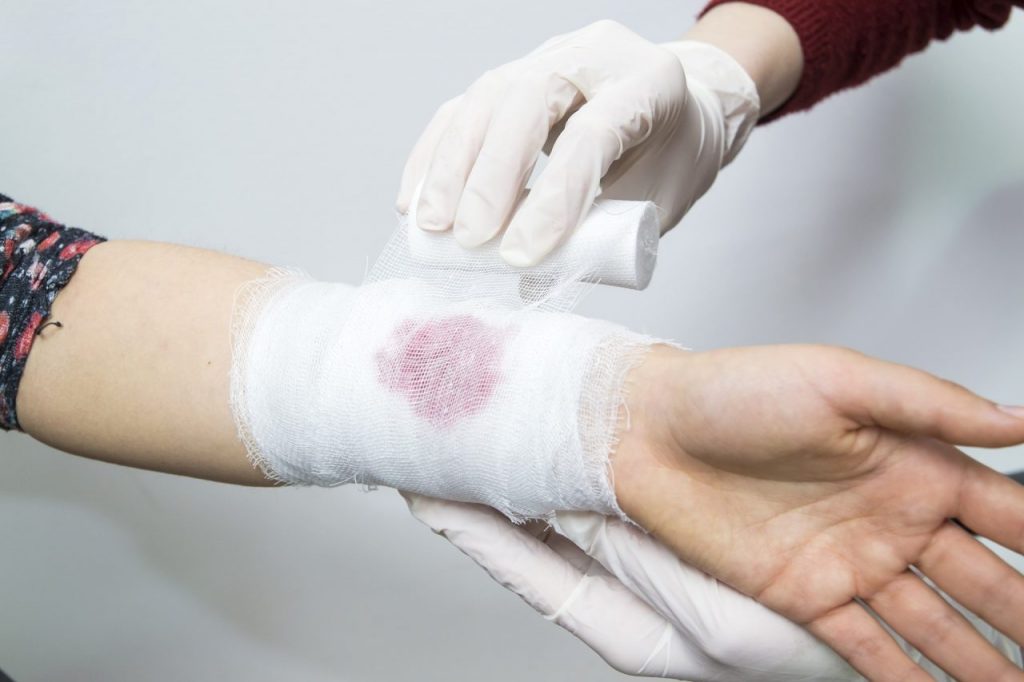Medical Emergency: How Can You Stop Bleeding?
Understanding Bleeding: Basics and Risks
Some of us think only accidents happen to those who take part in risky behavior or are on the more adventurous side, but the truth is an accident can occur anywhere at any time. Besides choking, internal and external severe bleeding are some of the most common emergencies we experience and are unaccustomed to handling unless we have proper First Aid training and a first aid kit at hand.
Coast2Coast prepares all our participants for the worst so that when an emergency arises, they will know what to do and take charge. We take high pride in our teaching methods and in showing proper bandaging and wound care.
Life-threatening Bleeding
Bleeding emergencies may be simply fixed with a Band-Aid and some tissue, while other severe bleeding needs to be cared for quickly and efficiently or may cause life-threatening hemorrhages. Life-threatening bleeding refers to a situation where large amounts of blood loss occur either externally (outside the body) or internally (within the body), leading to a life-threatening condition if not treated immediately.
A situation like this can ensue whenever one or more of the body’s blood vessels are mutilated. This can easily result in loss of life and must be controlled immediately. Bleeding from arteries is often rapid and profuse, and it is always life-threatening. This is because arterial blood is under direct pressure from the heart, so it usually spurts from the wound, making it difficult for clots to form.
As a result, arterial bleeding is harder to control than the one from veins and capillary bleeding (small blood vessels). This involves large amounts of severe bleeding either outside the body (external) or within the body (internal). This severe bleeding requires immediate action.
Non Life Threatening Bleeding
Veins are damaged more often than arteries because they are closer to the top layer of skin. Bleeding from veins (venous bleeding) is easier to control than arterial. Venous blood is under less pressure than arterial blood and flows from the wound at a steady rate without spurting. In order for the bleeding to stop, apply direct pressure on the wound with sterile gauze from one of your first aid kits.
Signs of Life-Threatening External Bleeding
The signs and symptoms of life-threatening external bleeding include:
-
Blood spurting or flowing freely from a serious wound (like how a spout shoots out water).
-
Blood that fails to clot after you have taken all measures to control it.
-
Large amounts of blood loss.
-
Blood soaks through dressings or gauze pads, indicating that the bleeding is not under control.
-
Bleeding continues without stopping.
If any of these symptoms take place, remember all your knowledge of first aid for wounds, applying direct pressure, call 911 immediately and find an AED.

Inquire about First Aid & CPR Training Course
Want to learn how to stop bleeding? Register for a First Aid & CPR training course! Gain life-saving skills and be prepared.
First Aid for External Bleeding
It can be gruesome at first to see a lot of blood and a huge cut or gash in someone’s body. When providing first aid, it is crucial to avoid direct contact with the person’s blood to reduce the risk of infection. Always use protective measures such as disposable gloves or other barriers. It is best if you stay calm for them, as they are most likely in pain or are extremely scared of their well-being. If you are unable to physically help someone, find another friend or loved one; or if in public, find another bystander (preferably one who is First Aid certified) to administer the bandaging and care. If you are unable to find someone who is certified in First Aid, but willing to help, tell them to follow these directions, or for yourself:
-
Expose the wound by removing any extra clothing, including shirts, coats, pants, socks, gloves, etc.
-
Look for the pressure point and apply direct pressure to the wound with a towel, blanket, clothing, or anything that soaks up blood flow.
-
While maintaining direct pressure for a few minutes, apply a dressing and bandage/ointment that may help to keep the wound moist and help the healing process.
-
Reassess the wound to see if the pressure has stopped the bleeding. If the pressure hasn’t stopped, consider using a tourniquet (or a makeshift one with a clean cloth or clothing) if the wound is on a limb, that is two to three inches above the wound. If the blood goes through the bandages, DO NOT take them off. Just continue to put dressings over the old ones and make sure the tourniquet is tight and secure.
For embedded object wounds that are bleeding, do not remove the object, as it may be controlling the bleeding. Instead, pad firmly around the bleeding site and apply pressure to help manage the bleeding; ensure it’s enough blood to warrant concern. Seek emergency help to assess the injury, as they can properly remove the object and check for other injuries to ensure comprehensive care.
In our Emergency First Aid course, not only do we teach correct bandaging and placement, but also how to properly tie a tourniquet. We believe that to be ready for an emergency, you need to know everything and anything that can help a victim save their life.

Signs and Symptoms of Life-Threatening Internal Bleeding
When we think of bleeding, we mostly think of external bleeding, as that is what is mostly portrayed in the media for emergencies and accidents. What isn’t discussed commonly (but should be) is internal bleeding.
Internal bleeding is the escape of blood from arteries, veins, or capillaries into spaces in the body. Life-threatening internal bleeding usually occurs in injuries caused by a violent blunt force, such as when someone falls from a height, car accident, or physical assault. You should suspect it after any injury that involves a forceful blow to the body. It may also occur when a sharp object, such as a knife, penetrates the skin and bruises internal structures. These might be some of the symptoms a person with internal bleeding might show;
- Bruising in the injured area
- Soft tissues (the abdomen, tendons, ligaments) that are tender, swollen, or hard
- Blood in saliva or vomit
- Pain
- Severe thirst, nausea, and vomiting
- Anxiety
If internal bleeding transpires, call 911 right away, find an AED and seek medical help for the injured person immediately.
First Aid for Internal Bleeding
- Life-threatening internal bleeding, especially if it results from damage to an organ, requires medical attention.
- Help the bleeding person rest in the most comfortable position and provide continual care while waiting for EMS personnel to arrive.
- A person with life-threatening internal bleeding may be very thirsty, but giving anything by mouth (even water) can cause serious complications down the road.
- Monitor them until EMS arrives.
Register today with Coast2Coast and be someone’s next lifesaver! Bleeding emergencies occur more often than we suspect, so it’s in our best interest for all of us to be certified in First Aid safety. As a proud partner of the Canadian Red Cross, it is in our best interest to have everyone in our communities be first-aid certified!
How to Prevent Extensive Bleeding?
Life happens to us daily, and we have to be ready to handle any emergency at any moment, but there are several steps we can take to attempt prevention and have safety for us and our loved ones. The following precautions may reduce the likelihood of an injury that causes life-threatening bleeding:
-
Be familiar with your surroundings. Make sure there are no holes, loose wires, or any broken furniture or objects around.
-
Keep all sharp objects, such as knives, in a safe place. If small children are present, consider locking the compartment of sharp objects.
-
Get proper training on machinery in the workplace.
-
Always follow the outlined safety procedures when operating equipment.
-
Wear and use appropriate safety equipment at work and at home.
-
Only use the equipment for its intended purpose.
-
Stay alert when operating equipment.
When to Seek Medical Help
Seek medical help immediately if the bleeding is severe, life-threatening, or doesn’t stop after 10-15 minutes of direct pressure. If the injured person shows signs of shock, has a head injury, or is bleeding internally, seek medical attention right away. If you’re unsure about the severity of the wound or the person’s condition, err on the side of caution and seek medical help. Remember to always call 911 or the local emergency number in emergency situations. Prompt medical attention can be critical in managing life-threatening conditions and ensuring the injured person’s safety.


Register today with Coast2Coast and be someone’s next life saver! Bleeding emergencies occur more often than we suspect, so it’s in our best interest for all of us to be certified in First Aid safety. As a proud partner of the Canadian Red Cross, it is in our best interest to have everyone in our communities be first-aid certified!




















2 Comments
I am very thankful for your efforts put on this article.
This article is transparent, updated, and extremely informative.
Can I expect you will post this sort of another article in the near future?
Best regards,
Lunding Raahauge
You’re doing a excellent job Ma,,Keep up it.
Best regards,
Dinesen Dencker